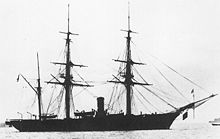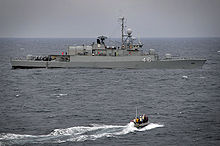- Corvette
-
This article is about the type of warship. For the car, see Chevrolet Corvette. For other uses, see Corvette (disambiguation).
Corvette 
French steam corvette Dupleix (1856–1887)Type Corvette Place of origin  French Navy
French NavyService history In service 1670–present Specifications Weight 500–2000 tons A corvette is a small, maneuverable, lightly armed warship, originally smaller than a frigate (2000+ tons) and larger than a coastal patrol craft or fast attack craft (500 or fewer tons),[1] although many recent designs resemble frigates in size and role. During the Age of Sail, corvettes were smaller than frigates and larger than sloops-of-war, usually with a single gun deck.
Although almost all modern navies use ships smaller than frigates for coastal duty, not all of them use the term corvette (via Middle French, from a Dutch word corf, a type of boat[2]) or equivalent. The rank "corvette captain" derives from the name of this type of ship.
Contents
Sailing vessels
During the Age of Sail, corvettes were one of many types of smaller warships. They were very closely related to sloops-of-war. The role of the corvette consisted mostly of coastal patrol, fighting minor wars, supporting large fleets, or participating in show-the-flag missions. The English Navy began using small ships in the 1650s, but described them as sloops rather than corvettes. The first reference to a corvette was with the French Navy in the 1670s, which may be where the term originated. The Royal Navy did not use the term until after the Napoleonic Wars to describe a small unrated vessel somewhat larger than a sloop.
Most corvettes and sloops of the 17th century were around 40 to 60 feet (12 to 18 m) in length and measured 40 to 70 tons burthen. They carried four to eight smaller guns on a single deck.
Over time, vessels of increasing size and capability were called corvettes; by 1800 they reached lengths of over 100 feet (30 m) and measured from 400 to 600 tons burthen. One of the largest corvettes during the Age of Sail was the American ship USS Constellation, built in 1855; at 176 feet (54 m) long, she carried 24 guns. She was so large that some naval experts consider her a frigate.
Steam ships
Ships during the steam era became much faster and more maneuverable than their sail ancestors. Corvettes during this era were typically used alongside gunboats during colonial missions. Battleships and other large vessels were unnecessary when fighting the indigenous people of the Far East and Africa.
World War II
The modern corvette appeared during World War II as an easily built patrol and convoy escort vessel. The British naval designer William Reed drew up a small ship based on the single-shaft Smiths Dock Company whale catcher Southern Pride, whose simple design and mercantile construction standards lent itself to rapid production in large numbers in small yards unused to naval work. First Lord of the Admiralty Winston Churchill, later Prime Minister, had a hand in reviving the name "corvette".
During the arms buildup leading to World War II the term "corvette" was almost attached to the Tribal-class destroyer. The Tribals were so much larger than and sufficiently different from other British destroyers that some consideration was given to resurrecting the classification of "corvette" and applying it to them. This idea was dropped, and the term applied to small, mass-produced anti-submarine escorts such as the Flower class of World War II.
The first modern corvettes were the Flower class (Royal Navy corvettes were named after flowers, and ships in Royal Canadian Navy service took the name of smaller Canadian cities and towns). Their chief duty was to protect convoys throughout the Battle of the Atlantic and on the routes from the UK to Murmansk carrying supplies to the Soviet Union.
The Flower-class corvette was originally designed for offshore patrol work, and was not ideal as an anti-submarine escort; they were really too short for open ocean work, too lightly armed for anti-aircraft defence, and little faster than the merchantmen they escorted, a particular problem given the faster German U-boat designs then emerging. They were very seaworthy and maneuverable, but living conditions for ocean voyages were appalling. Because of this the corvette was superseded in the Royal Navy as the escort ship of choice by the frigate, which was larger, faster, better armed and had two shafts. However, many small yards could not produce vessels of frigate size, so an improved corvette design, the Castle class, was introduced later in the war, some remaining in service until the mid-1950s.
The Royal Australian Navy built 60 Bathurst-class corvettes, including 20 for the Royal Navy crewed by Australians, and 4 for the Royal Indian Navy. These were officially described as Australian mine sweepers, or as minesweeping sloops by the Royal Navy, and were named after Australian towns.
The Bird-class minesweepers or trawlers were referred to as corvettes in the Royal New Zealand Navy, and two, Kiwi and Moa, rammed and sank a much larger Japanese submarine, the I-1, in 1943 in the Solomons.
Modern corvettes
 Argentine MEKO Espora-class corvette
Argentine MEKO Espora-class corvette
 Corvette Comandante Foscari of the Italian Navy.
Corvette Comandante Foscari of the Italian Navy.
Modern navies began a trend in the late 20th and early 21st century towards smaller, more maneuverable surface capability. Corvettes have a displacement between 540 and 2,750 long tons (550 and 2,790 t) and measure 180–330 feet (55–100 m) in length. They are usually armed with medium- and small-caliber guns, surface-to-surface missiles, surface-to-air missiles, and underwater warfare weapons. Many can accommodate a small or medium anti-submarine warfare helicopter.
Most countries with coastlines can build corvette size ships, either as part of their commercial shipbuilding activities or in purpose built yards, however the sensors, weapons and other systems required for a surface combatant are more specialized and are around sixty percent of the total cost. These components are purchased on the international market.[3]
Current corvette classes
Many countries today operate corvettes; some include Brazil, Bulgaria, China, Denmark, Germany, Greece, India, Indonesia, Israel, Italy, Pakistan, Philippines, Poland, Portugal, Romania, Russia, South Korea, Sweden and Turkey. Countries that border smaller seas, such as the Baltic Sea or the Persian Gulf, are more likely to build the smaller and more maneuverable corvettes.
One of the most advanced corvettes in service today is the Royal Norwegian Navy's Skjold class. It is the first operational warship to use stealth technology extensively.
The United States is developing Littoral Combat Ships, which will be very similar to a corvette, but their larger hulls permit space for mission modules, allowing them to undertake tasks formerly assigned to specialist classes such as minesweepers or the anti-submarine Oliver Hazard Perry-class frigate.
The new German Braunschweig class is designed to supplement Germany's fast attack craft and also incorporates stealth technology and land attack capabilities.
Turkey began to build MİLGEM-class corvettes in 2005. The MİLGEM class is designed for anti-submarine warfare and littoral patrol duty. The lead ship, TCG Heybeliada, entered navy service in 2011. The design concept and mission profile of the MİLGEM class is similar to the Freedom class of littoral combat ships of the United States.
The Hellenic Navy has categorised the class as fast attack missile craft. A similar vessel is the Kilic-class fast attack missile craft of the Turkish Navy, which is classified as a corvette by Lürssen Werft, the German ship designer.
Corvettes preserved as museum ships
- ARA Uruguay, 1874 steam and sail barque, Buenos Aires, Argentina
- HMAS Castlemaine, 1941 Bathurst-class corvette, Williamstown, Victoria, Australia
- HMCS Sackville, 1941 Flower-class corvette, Halifax, Nova Scotia
- HMAS Whyalla, 1941 Bathurst-class corvette, Whyalla, South Australia, Australia
- FNS Karjala, 1968 Turunmaa-class corvette, Turku, Finland
- Hiddensee, 1984 Tarantull-class missile corvette, Fall River, Massachusetts
See also
Further reading
- The collection Three Corvettes by Nicholas Monsarrat recounts the writer's World War II experiences on corvettes, starting as an inexperienced small-boat sailor and ending as captain.
- The novel The Cruel Sea also by Nicholas Monsarrat, which is about the life and death of a Flower-class corvette and the men in her, is regarded as one of the classic naval stories of World War II.
- The two books The Corvette Navy and On the Triangle Run by James B. Lamb give an autobiographical and historical perspective of life on Royal Canadian Navy corvettes in World War II. The author served on them for 6 years from Halifax to the beaches of D-Day.
References
- ^ In a class of their own: new corvettes take centre stage
- ^ "corvette". Merriam-Webster. http://www.merriam-webster.com/dictionary/corvette. Retrieved 2011-08-13.
- ^ Magnuson, Stew. "East/West Divide Grows In the International Navy Shipbuilding Business." National Defense Industrial Association, 16 May 2011.
External links
Types of sailing vessels and rigs - Barca-longa
- Barque
- Barquentine
- Bermuda rig
- Bermuda sloop
- Bilander
- Brig
- Brigantine
- Caravel
- Carrack
- Catamaran
- Catboat
- Clipper
- Dutch clipper
- Cog
- Corvette
- Cutter
- Dhow
- Dinghy
- East Indiaman
- Falkuša
- Felucca
- Fifie
- Fluyt
- Fore-and-aft rig
- Frigate
- Full rigged pinnace
- Full rigged ship
- Fusta
- Gaff rig
- Galeas
- Galleon
- Gunter rig
- Hermaphrodite brig
- Herring buss
- Hoy
- Jackass-barque
- Jangada
- Junk
- Ketch
- Koch
- Longship
- Lugger
- Man-of-war
- Mast aft rig
- Masula
- Mersey Flat
- Multihull
- Nao
- Nordland
- Norfolk punt
- Norfolk wherry
- Pausik
- Pilot cutter
- Pink
- Pinnace (ship's boat)
- Pocket cruiser
- Polacca
- Pram
- Proa
- Razee
- Sailing barge
- Sailing hydrofoil
- Scow
- Schooner
- Ship of the line
- Sixareen
- Sgoth
- Shitik
- Sloop
- Sloop-of-war
- Smack
- Snow
- Square rig
- Tall ship
- Thames sailing barge
- Trailer sailer
- Treasure ship
- Trimaran
- Uru
- Vinta
- Well smack
- Wherry
- Windjammer
- Windsurfer
- Xebec
- Yacht
- Yawl
- Yoal
Categories:- Ship types
- Corvettes
Wikimedia Foundation. 2010.




